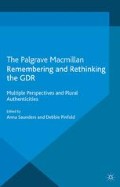Abstract
Since the mid-1990s, Berlin has often been diagnosed as suffering from an acute case of ‘monumentitis’, an affliction which relates to both the number of monuments being constructed, and the protracted and controversial debates which accompany their construction and reception. On the one hand, this trend can be witnessed internationally as part of the contemporary ‘memory boom’; on the other, Berlin proves to be an extreme example, as demonstrated by a plethora of recent publications about the role of memory in this city (e.g. Ladd, 1997; Till, 2005; Jordan, 2006; Verheyen, 2008; Webber, 2008). Indeed, as the capital of a new, united Germany, Berlin has become a national ‘theatre of memory’ (Samuel, 1994) in which new cultural and political symbolism is being staged, and where the reconfiguration of a ‘normalised’ identity has — in the wake of two dictatorships and a divided Germany — challenged politicians and artists alike. Although the role of monuments has changed considerably during the twentieth century, from overt expressions of power to more ambiguous or subversive forms (Mittig, 1987), they continue to act as ‘symbols and repositories of memories’ (Ladd, 1997: 4), and play an important role in the construction — or rejection — of collective identities.
Access this chapter
Tax calculation will be finalised at checkout
Purchases are for personal use only
Preview
Unable to display preview. Download preview PDF.
References
Assmann, A. (2006) Der lange Schatten der Vergangenheit. Erinnerungskultur und Geschichtspolitik (Munich: Beck).
Assmann, J. (1999), Das kulturelle Gedächtnis (Munich: Beck).
Apelt, A. H. (ed.) (2009) Der Weg zum Denkmal für Freiheit und Einheit (Schwalbach/Ts: Wochenschau).
Brussig, T. (2009) ‘Brussig: “Nicht die Künstler, wir haben versagt” ’, Tagesspiegel, 8 May, http://www.tagesspiegel.de/kultur/Einheitsdenkmal-Thomas-Brussig-Mitte;art772,2792018 [date accessed 8 September 2009].
Deutscher Bundestag (2000a) ‘Antrag’, Drucksache 14/3126, 6 April.
Deutscher Bundestag (2000b) ‘Plenarprotokoll, 14/99’, 13 April.
Deutscher Bundestag (2001) ‘Plenarprotokoll 14/199’, 9 November.
Deutscher Bundestag (2007a) ‘Beschlussempfehlung und Bericht’, Drucksache 16/6974, 7 November.
Deutscher Bundestag (2007b) ‘Plenarprotokoll 16/124’, 9 November.
‘Einheitsdenkmal soll auf den Berliner Schlossplatz’ (2008) Süddeutsche Zeitung, 13 March.
Finger, E. (2009) ‘Mehr Revolution wagen!’, Die Zeit, 9 July, 48.
Flügge, M. (2011) Interview on Deutschlandradio Kultur, 14 April, http://www.dradio.de/dkultur/sendungen/thema/1435816/ [date accessed 8 September 2011].
Gestaltungswettbewerb für ein Freiheits- und Einheitsdenkmal Berlin (2008) Auslobungstext — 1. Stufe (Berlin: Bundesamt für Bauwesen und Raumordnung).
Gestaltungswettbewerb für ein Freiheits- und Einheitsdenkmal in Berlin (2009) Dokumentation des offenen Wettbewerbs 2009 (Berlin: Bundesamt für Bauwesen und Raumordnung).
Hübner, W. (2009) ‘Einheit ohne Sockel’, Neues Deutschland, 7 July, 6.
Huyssen, A. (1995) Twilight Memories: Marking Time in a Culture of Amnesia (New York: Routledge).
Janzing, G. (2000) ‘Ein neuer Boom der Memorialkultur’, die tageszeitung, 8/9 April, 25.
Jeismann, M. (1999) Mahnmal Mitte. Eine Kontroverse (Cologne: DuMont).
Jordan, J. (2005) ‘A Matter of Time: Examining Collective Memory in Historical Perspective in Postwar Berlin’, Journal of Historical Sociology, 1, 37–71.
Jordan, J. (2006) Structures of Memory: Understanding Urban Change in Berlin and Beyond (Stanford, CA: Stanford University Press).
Kilb, A. (2009) ‘Einheitsdenkmal: Freiheit für die Schlümpfe’, FAZ.NET, 5 May, http://www.faz.net/s/RubCF3AEB154CE64960822FA5429A182360/Doc~ED2741788EED34C36BA131847A4F9D83D~ATpl~Ecommon~Scontent.html [date accessed 8 September 2009].
Klabach, K. (2009) Das Holocaust-Denkmal Berlin: Ein Sühnemahnmal des Deutschen Volkes? (Munich: Grin).
Ladd, B. (1997) The Ghosts of Berlin (Chicago: University of Chicago Press).
Leggewie, C. and E. Meyer (2005) Ein Ort, an den man gerne geht (Munich: Hanser).
Mania, A. (2009) ‘Ausstellung zum Wettbewerb für ein Freiheits- und Einheitsdenkmal, Berlin’, artnet, http://www.artnet.de/magazine/kommentar/mania/mania05–29–09.asp [date accessed 8 September 2009].
Mausbach, F. (2008) Über Sinn und Ort eines nationalen Freiheits- und Einheitsdenkmals (Berlin: Bundesamt für Bauwesen und Raumordnung).
Mittig, H.-E. (1987) ‘Das Denkmal’ in W. Busch and P. Schmoock (eds) Kunst. Die Geschichte ihrer Funktionen (Weinheim: Quadriga), pp. 457–89.
Nooke, G. (2006) ‘Ein Denkmal für die Einheit in Freiheit? Formen der Auseinandersetzung mit der DDR’ in P. März and H.-J. Veen (eds) Woran erinnern? Der Kommunismus in der deutschen Erinnerungskultur (Cologne: Böhlau), pp. 111–22.
Presse- und Informationsamt der Bundesregierung (2009a) ‘Neues Wettbewerbsverfahren zu Berliner Freiheits- und Einheitsdenkmal beschlossen’ (Pressemitteilung Nr.: 293), http://www.freiheits-und-einheitsdenkmal.de/edenkmal-exposee.php?id=46 [date accessed 7 September 2009].
Presse- und Informationsamt der Bundesregierung (2009b) ‘Kulturstaatsminister Bernd Neumann: Aufarbeitung der SED-Diktatur bleibt zentrale gesellschaftliche Aufgabe’ (Pressemitteilung Nr. 439), 9 November, http://www.bundesregierung.de/nn_1494/Content/DE/Pressemitteilungen/BPA/2009/11/2009–11–09-bkm-aufarbeitung-sed-diktatur.html [date accessed 4 February 2001].
Samuel, R. (1994) Theatres of Memory (London: Verso).
Schönfeld, M. (2009) ‘Kritisches Denkzeichen und restauratives Denkmal’ in T. Flierl and E. Müller (eds) Vom kritischen Gebrauch der Erinnerung (Berlin: Dietz), pp. 141–74.
sfk (2009) ‘ “Kompletter Schrott” Wettbewerb für Einheitsdenkmal’, Welt Online, 28 April, http://www.welt.de/kultur/article3641729/Wettbewerb-fuer-Einheitsdenkmal.html [date accessed 8 September 2009].
Stavginski, H.-G. (2002) Das Holocaust-Denkmal (Paderborn: Schöningh).
Thünemann, H. (2009) Holocaust-Rezeption und Geschichtskultur (Idstein: Schulz-Kirchner).
Till, K. (2005) The New Berlin: Memory, Politics, Place (Minneapolis, MN: University of Minnesota Press).
Verheyen, D. (2008) United City, Divided Memories? Cold War Legacies in Contemporary Berlin (Lanham: Lexington).
Webber, A. (2008) Berlin in the Twentieth Century: A Cultural Topography (Cambridge: Cambridge University Press).
Young, J. (2002) At Memory’s Edge: After-images of the Holocaust in Contemporary Art and Architecture (Yale: Yale University Press).
Editor information
Editors and Affiliations
Copyright information
© 2013 Anna Saunders
About this chapter
Cite this chapter
Saunders, A. (2013). The Politics of Memory in Berlin’s Freiheits- und Einheitsdenkmal . In: Saunders, A., Pinfold, D. (eds) Remembering and Rethinking the GDR. Palgrave Macmillan Memory Studies. Palgrave Macmillan, London. https://doi.org/10.1057/9781137292094_11
Download citation
DOI: https://doi.org/10.1057/9781137292094_11
Publisher Name: Palgrave Macmillan, London
Print ISBN: 978-1-349-34792-6
Online ISBN: 978-1-137-29209-4
eBook Packages: Palgrave Media & Culture CollectionLiterature, Cultural and Media Studies (R0)

